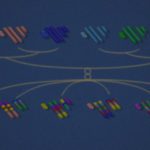Lien vers Pubmed [PMID] – 8828840
Biol. Reprod. 1996 Aug; 55(2): 355-63
We have investigated the male sterility associated with a new recessive mutation of the house mouse: ébouriffé (ebo). All spermatozoa present in the epididymis showed severe malformations, mostly of the tail. Light and electron microscopy showed a drastic decrease of the spermatid population, whereas spermatogonia and spermatocytes seemed moderately affected. This suggests that the mutation affects mostly spermiogenesis. Defects appeared during formation of the acrosome: the acrosomal granule was frequently vacuolated at stages II-III, giving rise first to abnormal acrosomes (stages VI-VII) with dilations and perforations, and then to an abnormal head and acrosome shape (stages IX-XI). However, the most common malformations affected the flagella in elongated spermatids. Sometimes the centriole doublet did not move into the implantation fossa, causing an unattached and isolated flagellum. The major defect occurred in the midpiece region of differentiating spermatozoa: flagellar components were present but highly disorganized, and mitochondria were aggregated in a compact mass. Even though we have no evidence that the ebo gene is a testis structural gene or a regulatory gene that disrupts the complex spermatogenesis process, this mutation may provide an interesting tool for studying the late stages of spermatogenesis. Using an interspecific backcross, we localized the ebo mutation on chromosome 2, with no recombination out of 44 meioses with locus D2Mit32.

